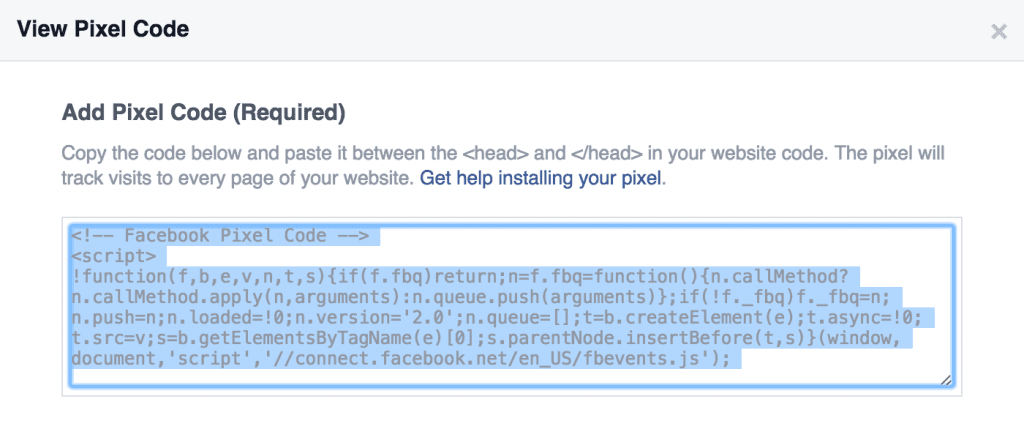Facebook Ad Sets Optimization: 5 Crucial Tips For Maximum ROI

Even though all the teens seem to be living their best lives on TikTok, Facebook is still very far from dead and over.
The platform reaches 59% of the world’s population, and is the third most-visited website in the world. As such, it can certainly be leveraged for brand growth in a number of ways: paid advertising being one of the most lucrative ones.
Let’s explore the 5 essential tips for optimizing your Facebook ad sets, for maximum return on investment and improved conversions.
1- Install Facebook Pixel
First of all, you need to ensure you have installed Facebook Pixel on your website.
The Pixel is a tiny piece of code that you add to your website, which then tracks how visitors interact with your pages. This data informs Facebook about their background, interests and behaviors, and enables better ad targeting based on real-life user data.
Configuring Pixel is fairly easy, and the data it reaps will ensure your ads are always shown to the right audience segment, increasing your click-through rates, and improving your ROI.
In order to get the best results, you need to make sure you are also optimizing for iOS 14 users – make sure your domain is verified, re-configure your preset settings in the Ads Manager, and select a single domain for tracking conversions.
2- Create Target Audience Personas
Defining your target audience is the second critically important step in ad set optimization. You can rely on Facebook’s own Lookalike Audiences or Audience Insights features, or you can also create your own personas based on user data you have previously gathered.
Relying on your own information sources (like Google Analytics and Search Console, or any other apps you use for the purpose) can give you that much-needed edge. After all, Facebook doesn’t understand your audience as well as you do.
Always start with the pain points your brand can solve. Why would someone do business with you? What can you do to help them solve an issue? What is it they would like to know about your brand?
Once you have an answer to these questions, start defining different audience segments based on demographics, interests, behaviors, etc. Make sure you have distinct personas for different services or product categories, pain points and income levels, age groups, and brand experiences.
Not only will this research help you increase your ad ROI, it’s a great way to lower your cost-per-click too.
3- A/B Test Your Ads
In paid advertising, copywriting and design are often just as important as targeting and ad timings.
In order to ensure your ad sets are doing their best for your brand, you should A/B test them as often as possible. For one, Facebook may have implemented changes you were not aware of, and it also gives you the chance to further improve even your best ad campaigns.
The ad elements you should A/B test (always one at a time!) include:
- Ad design
- Ad visuals
- Ad copy – specifically focusing on the headline
- Ad placement
- Call to action
- Bidding method
- Target audience
A/B testing is made easy through the Ads Manager, so you should have no trouble implementing various tests as often as you need to.
4- Use Intelligent (Re)targeting
Targeting and retargeting play a vital role in paid advertising.
First, you want to be crystal clear about the kinds of ads that certain audience segments want to see. For example, if you have a product that specifically appeals to parents, don’t serve it to teenagers. Sticking to our point about “know what the pain point is and solve it”, make sure you match the ad to the user as granularly as possible.
This might initially be a tougher cookie to crack, but the longer you run your ads, and the more Facebook Pixel learns about your audience, the easier it will become.
When it comes to retargeting, make sure you add those who have already visited your site to this audience. You also need to choose the right time frame: if your products can be considered an impulse purchase, or if you sell an item that is often shopped for, you can target 30-day audiences. But if customers need more time to make a decision, then you can target 60-day audiences.
Always ensure that audiences who have previously converted see a different ad than first-time potential customers and leads. Show them something extra, give them a discount, make a special offer – they will appreciate it.
5- Stand Out and Be True to Yourself
Finally, in order to truly make the most of your ad spend, you should do your very best to stand out from your competition.
Most brands will do some competitor research (whether through the Ads Manager or on another platform or even through Google) before running an ad campaign. They will then merely adapt the targeting practices and ad formats that work best in the niche.
While this practice is perfectly legitimate, you risk becoming no more than just another business in the crowd. Instead, try to put a twist on the best practices. If most competitors use images, try doing video. If they keep promoting their blog posts, make yours more informative and more valuable.
By structuring your ads so that they are likely to spark high engagement rates, you will instantly be seeing an improved ROI as well.
Final Thoughts
Ultimately, the formula for maximizing the return on investment of your Facebook ad sets is simple: you need to create ads that are in line with your target audience’s needs and interests, and put them out at the right time.
With a bit of research, clever copywriting, and continuous testing, you will be able to optimize your ads for better conversions – and take your brand to the next level.
Facebook Faces Yet Another Outage: Platform Encounters Technical Issues Again

Uppdated: It seems that today’s issues with Facebook haven’t affected as many users as the last time. A smaller group of people appears to be impacted this time around, which is a relief compared to the larger incident before. Nevertheless, it’s still frustrating for those affected, and hopefully, the issues will be resolved soon by the Facebook team.
Facebook had another problem today (March 20, 2024). According to Downdetector, a website that shows when other websites are not working, many people had trouble using Facebook.
This isn’t the first time Facebook has had issues. Just a little while ago, there was another problem that stopped people from using the site. Today, when people tried to use Facebook, it didn’t work like it should. People couldn’t see their friends’ posts, and sometimes the website wouldn’t even load.
Downdetector, which watches out for problems on websites, showed that lots of people were having trouble with Facebook. People from all over the world said they couldn’t use the site, and they were not happy about it.
When websites like Facebook have problems, it affects a lot of people. It’s not just about not being able to see posts or chat with friends. It can also impact businesses that use Facebook to reach customers.
Since Facebook owns Messenger and Instagram, the problems with Facebook also meant that people had trouble using these apps. It made the situation even more frustrating for many users, who rely on these apps to stay connected with others.
During this recent problem, one thing is obvious: the internet is always changing, and even big websites like Facebook can have problems. While people wait for Facebook to fix the issue, it shows us how easily things online can go wrong. It’s a good reminder that we should have backup plans for staying connected online, just in case something like this happens again.
Christian family goes in hiding after being cleared of blasphemy

LAHORE, Pakistan — A court in Pakistan granted bail to a Christian falsely charged with blasphemy, but he and his family have separated and gone into hiding amid threats to their lives, sources said.
Haroon Shahzad, 45, was released from Sargodha District Jail on Nov. 15, said his attorney, Aneeqa Maria. Shahzad was charged with blasphemy on June 30 after posting Bible verses on Facebook that infuriated Muslims, causing dozens of Christian families in Chak 49 Shumaali, near Sargodha in Punjab Province, to flee their homes.
Lahore High Court Judge Ali Baqir Najfi granted bail on Nov. 6, but the decision and his release on Nov. 15 were not made public until now due to security fears for his life, Maria said.
Shahzad told Morning Star News by telephone from an undisclosed location that the false accusation has changed his family’s lives forever.
“My family has been on the run from the time I was implicated in this false charge and arrested by the police under mob pressure,” Shahzad told Morning Star News. “My eldest daughter had just started her second year in college, but it’s been more than four months now that she hasn’t been able to return to her institution. My other children are also unable to resume their education as my family is compelled to change their location after 15-20 days as a security precaution.”
Though he was not tortured during incarceration, he said, the pain of being away from his family and thinking about their well-being and safety gave him countless sleepless nights.
“All of this is due to the fact that the complainant, Imran Ladhar, has widely shared my photo on social media and declared me liable for death for alleged blasphemy,” he said in a choked voice. “As soon as Ladhar heard about my bail, he and his accomplices started gathering people in the village and incited them against me and my family. He’s trying his best to ensure that we are never able to go back to the village.”
Shahzad has met with his family only once since his release on bail, and they are unable to return to their village in the foreseeable future, he said.
“We are not together,” he told Morning Star News. “They are living at a relative’s house while I’m taking refuge elsewhere. I don’t know when this agonizing situation will come to an end.”
The Christian said the complainant, said to be a member of Islamist extremist party Tehreek-e-Labbaik Pakistan and also allegedly connected with banned terrorist group Lashkar-e-Jhangvi, filed the charge because of a grudge. Shahzad said he and his family had obtained valuable government land and allotted it for construction of a church building, and Ladhar and others had filed multiple cases against the allotment and lost all of them after a four-year legal battle.
“Another probable reason for Ladhar’s jealousy could be that we were financially better off than most Christian families of the village,” he said. “I was running a successful paint business in Sargodha city, but that too has shut down due to this case.”
Regarding the social media post, Shahzad said he had no intention of hurting Muslim sentiments by sharing the biblical verse on his Facebook page.
“I posted the verse a week before Eid Al Adha [Feast of the Sacrifice] but I had no idea that it would be used to target me and my family,” he said. “In fact, when I came to know that Ladhar was provoking the villagers against me, I deleted the post and decided to meet the village elders to explain my position.”
The village elders were already influenced by Ladhar and refused to listen to him, Shahzad said.
“I was left with no option but to flee the village when I heard that Ladhar was amassing a mob to attack me,” he said.
Shahzad pleaded with government authorities for justice, saying he should not be punished for sharing a verse from the Bible that in no way constituted blasphemy.
Similar to other cases
Shahzad’s attorney, Maria, told Morning Star News that events in Shahzad’s case were similar to other blasphemy cases filed against Christians.
“Defective investigation, mala fide on the part of the police and complainant, violent protests against the accused persons and threats to them and their families, forcing their displacement from their ancestral areas, have become hallmarks of all blasphemy allegations in Pakistan,” said Maria, head of The Voice Society, a Christian paralegal organization.
She said that the case filed against Shahzad was gross violation of Section 196 of the Criminal Procedure Code (CrPC), which states that police cannot register a case under the Section 295-A blasphemy statute against a private citizen without the approval of the provincial government or federal agencies.
Maria added that Shahzad and his family have continued to suffer even though there was no evidence of blasphemy.
“The social stigma attached with a blasphemy accusation will likely have a long-lasting impact on their lives, whereas his accuser, Imran Ladhar, would not have to face any consequence of his false accusation,” she said.
The judge who granted bail noted that Shahzad was charged with blasphemy under Section 295-A, which is a non-cognizable offense, and Section 298, which is bailable. The judge also noted that police had not submitted the forensic report of Shahzad’s cell phone and said evidence was required to prove that the social media was blasphemous, according to Maria.
Bail was set at 100,000 Pakistani rupees (US $350) and two personal sureties, and the judge ordered police to further investigate, she said.
Shahzad, a paint contractor, on June 29 posted on his Facebook page 1 Cor. 10:18-21 regarding food sacrificed to idols, as Muslims were beginning the four-day festival of Eid al-Adha, which involves slaughtering an animal and sharing the meat.
A Muslim villager took a screenshot of the post, sent it to local social media groups and accused Shahzad of likening Muslims to pagans and disrespecting the Abrahamic tradition of animal sacrifice.
Though Shahzad made no comment in the post, inflammatory or otherwise, the situation became tense after Friday prayers when announcements were made from mosque loudspeakers telling people to gather for a protest, family sources previously told Morning Star News.
Fearing violence as mobs grew in the village, most Christian families fled their homes, leaving everything behind.
In a bid to restore order, the police registered a case against Shahzad under Sections 295-A and 298. Section 295-A relates to “deliberate and malicious acts intended to outrage religious feelings of any class by insulting its religion or religious beliefs” and is punishable with imprisonment of up to 10 years and fine, or both. Section 298 prescribes up to one year in prison and a fine, or both, for hurting religious sentiments.
Pakistan ranked seventh on Open Doors’ 2023 World Watch List of the most difficult places to be a Christian, up from eighth the previous year.
Morning Star News is the only independent news service focusing exclusively on the persecution of Christians. The nonprofit’s mission is to provide complete, reliable, even-handed news in order to empower those in the free world to help persecuted Christians, and to encourage persecuted Christians by informing them that they are not alone in their suffering.
Free Religious Freedom Updates
Join thousands of others to get the FREEDOM POST newsletter for free, sent twice a week from The Christian Post.
Individual + Team Stats: Hornets vs. Timberwolves
CHARLOTTE HORNETS MINNESOTA TIMBERWOLVES You can follow us for future coverage by liking us on Facebook & following us on X: Facebook – All Hornets X – …
Source link
-

 SEARCHENGINES7 days ago
SEARCHENGINES7 days agoGoogle Core Update Volatility, Helpful Content Update Gone, Dangerous Google Search Results & Google Ads Confusion
-

 SEO7 days ago
SEO7 days ago10 Paid Search & PPC Planning Best Practices
-

 MARKETING5 days ago
MARKETING5 days ago5 Psychological Tactics to Write Better Emails
-

 SEARCHENGINES5 days ago
SEARCHENGINES5 days agoWeekend Google Core Ranking Volatility
-

 SEO6 days ago
SEO6 days agoWordPress Releases A Performance Plugin For “Near-Instant Load Times”
-

 MARKETING6 days ago
MARKETING6 days agoThe power of program management in martech
-
SEARCHENGINES4 days ago
Daily Search Forum Recap: April 15, 2024
-

 PPC5 days ago
PPC5 days ago20 Neuromarketing Techniques & Triggers for Better-Converting Copy















